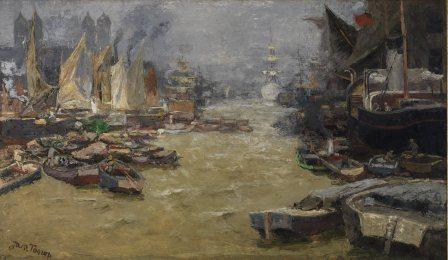E. and C.’s position
In short and in so far as is it of interest in this case, the position taken by E. and C. is as follows.
E. and C. claim that the sale of Thames at London by Flersheim should be regarded as involuntary. In their opinion, restitution of this work to them, is, therefore, appropriate as they are the sole heirs to their mother, who in turn was the sole surviving heir to her father, Flersheim.
The burden of proof regarding the involuntary loss of possession should not rest on them. E. and C. describe Flersheim as a wealthy German of Jewish origin, living in Frankfurt am Main, who decided to flee to the Netherlands as a consequence of persecution by the Nazis. He was forced to leave many of his possessions behind in Germany, including the lion’s share of his art collection, or to sell them to pay for his escape. He only took two paintings, including Thames at London, with him.
E. and C. adduce that, in March 1937, Flersheim received a visa for the Netherlands and left Germany in haste because he feared reprisals. After his escape, which would eventually take him to the Netherlands, he took his gravely ill daughter to a spa in Alassio, Italy, from where he negotiated and sold Thames at London to the art dealer G.J. Nieuwenhuizen Segaar in The Hague on 20 March 1937.
E. and C. refer to this as being a sale while in the act of flight, and in this respect defend the analogous application of the government’s policy with regard to the restitution of works of art from the national collection, in the sense that Flersheim’s sale of the painting while on the run is the same as the Jews selling their possessions in Germany during the same period, namely after 1933. The fact that Flersheim was registered in the population register in Amsterdam on 16 March 1937 is, according to them, irrelevant.
E. and C. are of the opinion that it is implausible that Flersheim, who needed the extra finances to maintain himself and his family and to pay for his escape to the Netherlands, had access to the NLG 3,500 he received for the sale of the painting. In cases of doubt, the Committee should give Flersheim the benefit of the doubt, in accordance with the government’s policy guidelines.
Nieuwenhuizen Segaar sold Thames at London to the Museum within a few days of concluding the transaction with Flersheim. E. and C. criticise Nieuwenhuizen Segaar, who made an unusually high profit from the sale (43%).
Information found in the Museum’s archive with regard to Thames at London is limited to a summary of its provenance. E. and C. agree with critical post-war publications concerning the position of Museum director Dirk Hannema with regard to the purchase of artworks formerly in the possession of Jews. Furthermore, E. and C. point to correspondence from 1954 between the Wiedergutmachungskammer des Landgerichts Frankfurt am Main and the Museum, when the former was said to have enquired about artworks from Flersheim’s former collection, including Thames at London, but were kept at arm’s length by the Museum.
E. and C. consider their interest in the restitution of Thames at London to be significant. They point to the fact that there was a close personal bond between the Flersheims and Toorop and argue that Flersheim would not have sold the painting had it not been out of financial necessity.
In a letter dated 14 November 2007, E. and C. stated that they were also willing to pay Rotterdam Municipal Council the indexed purchase price for Thames at London.
